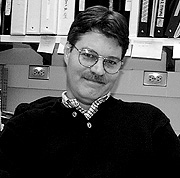
| T H E N I H C A T A L Y S T | M A R C H - A P R I L 1999 |
|
|
|
| P E O P L E |
RECENTLY
TENURED
 |
|
Paul
Love
|
Paul Love received M.D. and Ph.D. degrees from the University of Rochester (N.Y.) in 1987 and completed a residency in clinical pathology at Washington University in St. Louis. He joined NICHD as a medical staff fellow and became head of the Unit on Cellular and Developmental Biology in 1993. He is now a senior investigator in the Laboratory of Mammalian Genes and Development.
My research interests are directed at understanding the cellular and genetic events that regulate T lymphocyte development. A major focus of my work has been on the role in thymocyte maturation of signals transduced by cell surface receptors, particularly the T-cell antigen receptor (TCR). In mature T-cells, the TCR is centrally involved in antigen recognition, T-cell activation, and cell-mediated immunity. In developing thymocytes, TCR signals are important for maturation and thymic (positive and negative) selection. How the TCR is capable of orchestrating these various processes remains a central question in immunology.
In a series of experiments conducted over the past several years, my lab has systematically dissected and characterized the function of the multiple signal-transducing sequences contained within the TCR complex. TCR signal-transduction sequences (termed immunoreceptor tyrosine-based activation motifs; ITAMs) are contained within four distinct subunits of the multimeric TCR complex (z, CD3-g, -d, -e) and are triplicated in the z-chain cytoplasmic domain. Di-tyrosine residues within ITAMs are phosphorylated upon TCR engagement and function to recruit signaling molecules, such as protein tyrosine kinases, to the TCR complex, thereby initiating the T-cell activation cascade. To examine the role of individual TCR signaling subunits in development, we generated knockout mice lacking either z or CD3e by gene targeting. The phenotype of these mice revealed critical functions for these subunits in promoting TCR surface expression and T-cell development. The importance of specific TCR-ITAMs was then examined by reconstituting TCR surface expression in z-/-, CD3e-/-, or z-/- x e-/- mice using transgenes that encode full-length z- and/or e-chains or ITAM mutant (signaling-defective) variants of these proteins. Examination of T-cell development in these mice revealed the striking finding that neither z-chain nor CD3e signals are specifically required for T-cell maturation. Thus, the multiple TCR signaling motifs appear to have redundant signaling functions. We further learned that the multiple ITAM configuration of the TCR is especially important for thymocyte selection (a developmental process that ensures maturation of self-educated T-cells and prevents maturation of potentially autoreactive T-cells). These results identify an in vivo function for the multiple ITAM-TCR structure in signal amplification.
We have also used these TCR signaling variant models to search for other cell-surface structures that can influence (positively or negatively) the TCR signaling response. The analysis of one such molecule, CD5, which has been shown to negatively regulate TCR signaling and to participate in thymocyte selection, constitutes another area of investigation in the laboratory. We found that CD5 surface levels are developmentally regulated by TCR signaling intensity and by the affinity of the TCR for selecting ligands. These results support a role for CD5 in modulating or fine tuning the TCR signaling response during development.
Finally, my lab is searching for genes that may be important for thymocyte maturation. These experiments have led to the identification of a novel protein tyrosine kinase (Txk) and protein tyrosine phosphatase (PTPK1). The phenotype of Txk transgenic mice generated in our lab indicates that Txk functions in the pathway leading to calcium mobilization after TCR engagement.
We are generating PTPK1-deficient
mice to examine the role in lymphocyte development of the protein tyrosine phosphatase
PTPK1, which is expressed in immature hematopoietic stem cells and early thymocytes.
Similar strategies are currently being used to identify other genes in the early
fetal thymus that may be important for T-cell development or T-lineage commitment.
Once identified, transgenic and/or knockout (null) mutations of these genes
can be generated to study their function in lymphopoiesis. ![]()